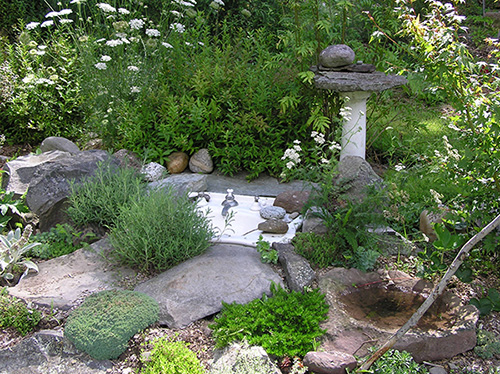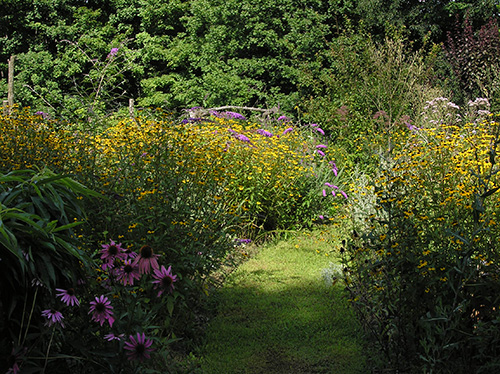Permaculture Gardening
When I first discovered permaculture gardening I knew I had found a path that would help me achieve my dreams. I've always felt called to actively participate in nature, feel connected to where I live, and provide for my needs while at the same time caring for and nurturing the place where I live. That is what permaculture is all about.

What is Permaculture Gardening?
Permaculture is a nature based design system full of principles and techniques meant to support the process of meeting our human needs (including food production) while at the same time regenerating the landscape. It's as much a philosophy and way of life as it is an approach to gardening. It's about recognizing that humans are a part of nature, and that our impact can not only be not negative, it can be positive and actually help the Earth regenerate faster than it would on its own.
The term Permaculture was coined by Bill Mollison and David Holmgren in the 1970's. But it has been practiced for much longer than that. I first learned about permaculture gardening at my first permaculture design course in northern New Mexico in the late 90's and had the pleasure of being taught by Justin Willie, a Native American of Navajo/Dineh descent. Justin used to say, "My people have been practicing permaculture for long before it was ever called this. It is our traditional way of life."
Indeed, humans have been practicing permaculture for tens of thousands of years. It's been wired into us since the beginning as hunters and gatherers. It is now well documented that our indigenous ancestors were sophisticated stewards of the land, practicing what we now refer to as permaculture or regenerative design. Interested? Check out the book Tending the Wild by M. Kat Anderson for more info.
The word permaculture is a hybrid of the words "permanent agriculture" or "permanent culture", and refers to creating a way of living where animals, plants, humans and all other life forms team up to produce an abundant, diverse and self-renewing system. To this end the goal is to get our basic and deeper needs met while simultaneously supporting the needs of our surrounding environment. When you put these things together, permaculture gardening is a beautiful approach to living in a symbiotic relationship with the place where you live.

Permaculture Systems
Permaculture gardening is all about creating systems that will be lasting and regenerative so you need to have a strategic, long term view. Here are some key principles to include in your permaculture gardening systems:
Integrating Connections
This is probably one of the most important elements to permaculture gardening and will be the umbrella that covers all the other principles I'm going to mention. Integrating Connections refers to incorporating the essential elements into your plan in a way that fosters healthy relationships and harmonious interactions. You want to have a well-functioning system that creates opportunities for all the critical elements to connect, especially the invisible ones. The visible elements are both affected and affect the invisible and vice versa.
For example, by knowing the water cycle, sun cycle, the climate, and microclimates (invisible elements) of the area where you live you'll be in a more advantageous position to pick an ideal location for setting up garden beds, orchards and sites where animals will dwell (all visible elements).
Diversity
Integrating diversity in your system shows up as the quantity and quality of symbiotic relationships that are present and nurturing each other. Diversity grows a solid foundation for a hardy, robust and flexible system! When you increase diversity you increase productive interactions among all species.
Edges are an excellent example of diversity because often that is where the most action takes place, where life is naturally drawn to. Look for edges where you live: places where water meets land, where forests meet fields, where creeks meet meadows. You can help by reintroducing native species and tend to plants that are growing there.
Zones
This is a way of organizing your activity so that you actually accomplish things easily. It's also a way of integrating the profile and patterns you've observed on the land. In permaculture gardening there are five standard zones you can organize and arrange things in so that the most human activity is close to home (zone 1) and the least frequent human activity is farther out away from home (zone 5).
Amongst other things, my zone 1 includes our home, our garden beds, and our chicken coop. I've designed this consciously so that the places that need my attention the most are right outside my door. Think conservation of energy. The design makes life simpler, more efficient, and more enjoyable.
Permaculture Techniques
Permaculture techniques are methods and practices that support the health of the overall system as well as individual structures you've put in place. There are a TON of possible permaculture techniques available for you to use; here are some of the most essential:
Site Observation and Analysis
Step back to observe patterns and take time to observe nature and interact with nature. It's worth it. You'll find that when you've observed the landscape in all the different seasons, through all the times of day, in all types of weather, you'll have a greater understanding of how to interact with that place, as well as the relationships already in place.
It's no different than interacting with people - you wouldn't just rush forward and marry someone you've never met before, good relationships take time to develop. Bring that same love, respect, and patience to the land where you live.
Imitating Nature
Nature is impeccable at permaculture gardening, it is the ultimate permaculture role model. Again, take time to connect with the natural world around your home and look for ways to imitate it.
For example, you could replicate a healthy forest by growing a food forest garden that includes ground cover, a shrub layer, a short tree layer, and a tall tree layer that work symbiotically. Design the plant layer to also attract a variety of beneficial life like butterflies, bats, bees and birds. Set up houses, feeders for these flying friends. Make sure that you have adequate shrubs and trees that will help add nitrogen to the soil, prevent harmful insects from coming in, offer shade to vulnerable seeds & small plants, and be a lattice for climbing plants.
With a well-designed food forest garden, you can have a self-regenerating system that produces seeds, nuts, berries, fruit, flowers, roots, herbs, vegetables and more, all while benefiting and giving back to the surrounding area.
Stacking Functions
How can you design multiple functions into a single structure? That is what nature does. It can actually be really simple to do. For example, I tend a small flock of chickens that help out with quite a few tasks beyond just producing eggs. They turn the soil, fertilize it with their manure, and eat potentially destructive insects, all which builds the soil and fosters plant life. They act as my compost when I give them my family's food scraps. They offer companionship and entertainment with their songs.
Essential benefits of Permaculture Gardening
Permaculture Gardening offers us a practice that develops humility. The root word of "humility", and "human", is "humus", which means "of the Earth". Perhaps one of the great lessons of our times is that we must consider the natural world and the people of both today and tomorrow as we make a living for ourselves. Certainly life isn't just a quest for greater material consumption, nor is it just about moving towards self-actualization.
I would offer that the journey of life becomes whole when we give ourselves fully to our very purpose for being, to our people, and to our land. May permaculture gardening help you achieve just that!
Permaculture Articles:
We invite you to check out our permaculture articles below as you continue to explore the world of regenerative design and building deeper connections. Enjoy!

How to Raise Chickens Naturally
Learn how to raise chickens holistically, by nature's design. Chicken raising can be simple and fun, and through it you can develop a deep connection.

What do Chickens Eat?
Answering the question what do chickens eat is essential to a chicken's health and well-being. Learn a regenerative approach to feeding chickens through the eyes of deep nature connection.

Growing Strawberries Naturally
Learn the best holistic practices and age old secrets for growing strawberries for food, pleasure, and connection. Everything you need to know right here in one place.
Interested in being personally mentored in Permaculture & Regenerative Design, on a transformational journey of connection to nature, community, and self?
Check out the Twin Eagles Wilderness Immersion Program.
comments powered by Disqus
Return from Permaculture Gardening to Wilderness Survival (homepage)
Track Us